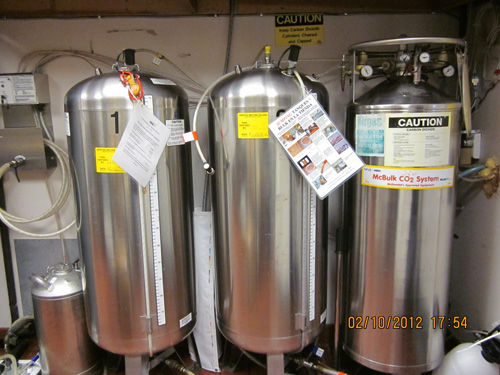CO2 canisters pose potential danger
In almost every restaurant with a soda fountain, there is a potentially dangerous threat not visible to the naked eye.
In 2012, the Phoenix, Arizona Fire Department responded to a scene where a pregnant McDonald’s employee had fallen from the top of a basement stairway.
Two firefighters descended into the basement upon arrival and immediately turned back around because they did not feel right. Coming back up the stairs, one of the firefighters fell down and the other reported feeling dizzy.
After an evacuation and a thorough investigation by a hazmat team, the department discovered a leaky Carbon Dioxide (CO2) tank. The tanks are regularly used in restaurants to carbonate soda.
Events such as this one in which people’s lives have been threatened, and in some cases lost, have brought to light the issue of improper CO2 storage in restaurants.
In recent years, many business owners have switched from pressurized CO2 tanks to liquid CO2 tanks, which are larger in size and last significantly longer.
“What’s changed is that more and more restaurants are having what’s called dewars,” said Sonoma County’s Hazardous Materials Program Manager Andrew Parsons. “Those are the big stainless steel containers that hold about 3,500 standard cubic feet of carbon dioxide gas, whereas a 20-pound cylinder only holds about 176 standard cubic feet.”
According to a press release from Sonoma County Fire & Emergency Service Department, CO2, similar to carbon monoxide, is noncombustible, colorless, tasteless and odorless.
“Carbon dioxide is heavier than air, and it quickly displaces oxygen and one ‘drowns’ in the oxygen-deficient atmosphere,” the press release stated. “It is often referred to as ‘drowning without water.’”
In Sonoma County, a Hazardous Materials Permit is required for CO2 storage if a business stores more than 1,000 standard cubic square feet of CO2 – about the amount of six 20-liter cylinders. Regardless of whether there are several smaller tanks or one large tank, if the CO2 amount is larger than the threshold, businesses must have a permit, local experts said.
The permit is issued by the Certified Unified Program Agency (CUPA), which is the Healdsburg Fire Department, and includes an annual hazmat fee of $288 for Healdsburg businesses that store C02 only for beverage carbonation.
Once businesses register with CUPA, the agency makes inspections every two to three years.
Healdsburg Fire Marshal Linda Collister said the permit requirement includes local restaurants, corporate fast food chains, gas stations and even breweries. She noted that although a good number of businesses in the city are regulated by CUPA, there are still some that have not yet received the proper permits.
Business owners must also provide Fire & Emergency Services a Hazardous Materials Business Plan (HMBP), which consists of general business information, health risks of hazardous materials and emergency response and training plans.
An HMBP is submitted electronically via the California Environmental Reporting System and can be accessed through www.
sonomacounty.ca.gov. Certification, employee training and the emergency plan must be updated on the HMBP annually.
Prior to any tank installations, businesses are required to obtain a one-time building permit of $103, according to Healdsburg Building Official Steve Buffenbarger, who advises businesses that may have installed a larger tank without the permit to contact the city and get one.
The Fire & Emergency Services also states that the most common violation in businesses is a lack of posted exterior and interior warning signs, which by California Fire Code should be visible at location entrances “where hazardous materials are stored, dispensed, used or handled in quantities requiring a permit.”
The Fire & Emergency Service Department is more actively enforcing these regulations, but Parsons said it is being done in a way that avoids getting people in trouble for breaking regulations – focusing on educating business owners on current laws and providing resources for restaurants to come into compliance.
“If you do have CO2 involved at your facility, make sure you call the Healdsburg Fire Department, and as the fire marshal I will help you,” Collister said.
76.8
F
Healdsburg
April 21, 2025









